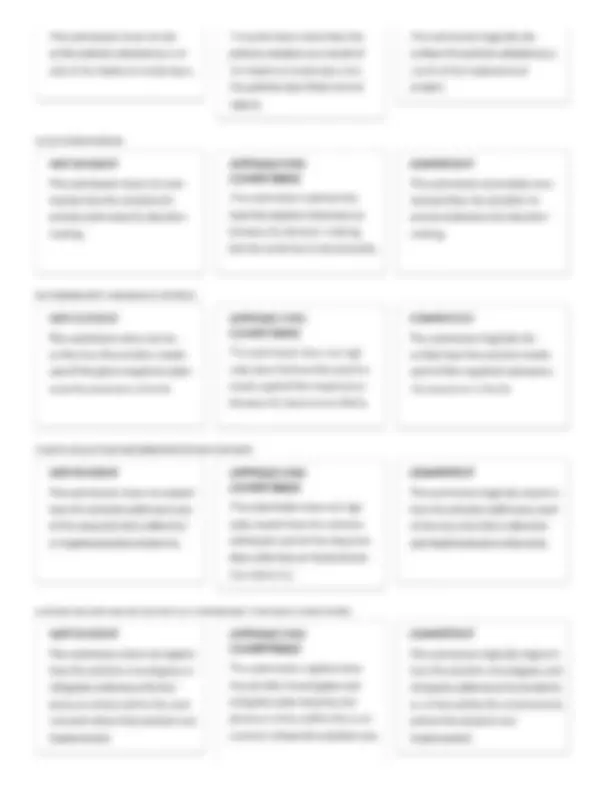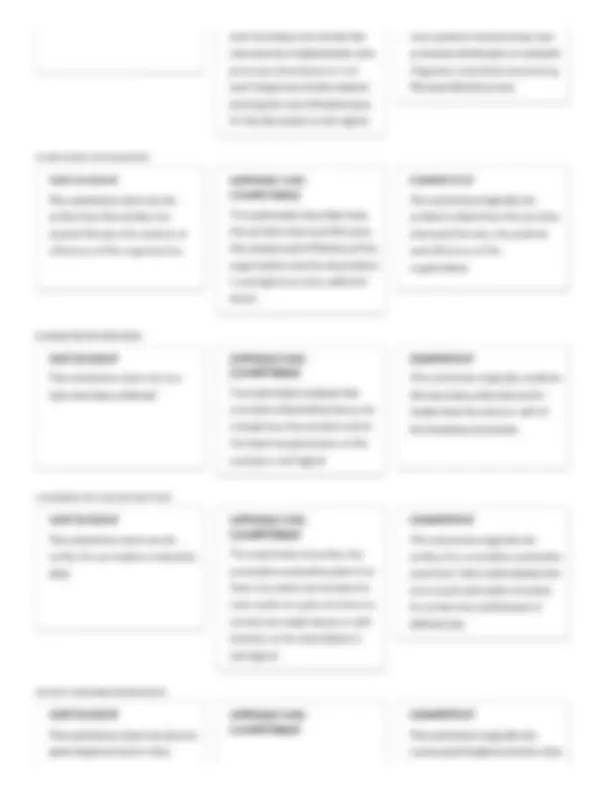Partial preview of the text
Download D490 - DDN1 — DDN1 TASK 3 TECHNOLOGY-SUPPORTED SECURITY SOLUTION and more Exercises Cybercrime, Cybersecurity and Data Privacy in PDF only on Docsity!
Heat maps DDN1 — DDN1 TASK 3: TECHNOLOGY-SUPPORTED SECURITY SOLUTION CYBERSECURITY GRADUATE CAPSTONE — D490 PRFA — DDN1 COMPETENCIES 981.4.1: Capstone The learner integrates and synthesizes competencies from across the degree program, thereby demonstrating the ability to participate in and contribute value to the chosen professional field. INTRODUCTION In this task, you will develop and implement the capstone project approved by your instructor. You will compile the information for your solution to your cybersecurity problem into a report. Your work for this task will not be evaluated until Task 2 has been submitted and evaluated. REQUIREMENTS Your submission must be your original work. No more than a combined total of 30% of the submission and no more than a 10% match to any one individual source can be directly quoted or closely paraphrased from sources, even if cited correctly. The similarity report that is provided when you submit your task can be used as a guide. You must use the rubric to direct the creation of your submission because it provides detailed criteria that will be used to evaluate your work. Each requirement below may be evaluated by more than one rubric aspect, The rubric aspect titles may contain hyperlinks to relevant portions of the course. Tasks may not be submitted as cloud links, such as links to Google Docs, Google Slides, OneDrive, etc., unless specified in the task requirements. All other submissions must be file types that are uploaded and submitted as attachments (e.g., .docx, .pdf, ppt). A. Describe the policies adopted as a result of your implemented project. 1. Summarize how the solution improves cybersecurity decision-making. B. Describe how your solution meets the following cybersecurity assurance criteria: promotes automation in cybersecurity © improves and modernizes security e implements industry-standard security tools and infrastructure or environment C. Explain how your solution addresses the following data collection and implementation elements: ¢ collects digital evidence, including data for analysis or forensics e implements confidentiality, integrity, and availability D. Explain how your solution investigates and mitigates cybersecurity incidents or crimes within the environment where the solution was implemented. E. Describe the cybersecurity plans, standards, or procedures that were developed for the solution. 1. Explain how the solution is aligned with cybersecurity initiatives or regulatory compliance in the environment where the solution was implemented. 2. Summarize the applications, tools, installation guides, or user guides you developed in conjunction with the solution. F. Discuss the post-implementation environment, including the new systems implemented, new processes developed, or network diagrams created demonstrating the new infrastructure. 1. Describe how the solution improved the security posture and efficiency of the organization. 2. Analyze the new data (e.g., new reports, logs, processes in place) collected, including how the solution will affect business processes. 3. Describe the summative evaluation plan from Task 2, including the test results and a plan of action to correct any weaknesses or deficiencies. 4. Discuss post-implementation risks, including their likelihood, organizational impact, and mitigation. 5. Explain how the security solution meets each of the project stakeholders' needs, including a description of the stakeholder needs as identified in Task 2. G. Describe the post-implementation maintenance plan for the solution. H. Provide one original artifact (e.g., security policy, procedure, network diagram) of the completed project. I. Acknowledge sources, using in-text citations and references, for content that is quoted, paraphrased, or summarized. J. Demonstrate professional communication in the content and presentation of your submission. File Restrictions File name may contain only letters, numbers, spaces, and these symbols: ! -_.*'() File size limit: 200 MB File types allowed: doc, docx, rtf, xls, xlsx, ppt, pptx, odt, pdf, csv, txt, qt, mov, mpg, avi, mp3, wav, mp4, wma, fly, asf, mpeg, wmv, m4y, svg, tif, tiff, jpeg, jpg, gif, png, zip, rar, tar, 7z RUBRIC A:POLICIES NOT EVIDENT APPROACHING COMPETENT COMPETENCE implemented, but the explana- tion is not logical. E:CYBERSECURITY PLANS, STANDARDS, OR PROCEDURES NOT EVIDENT The submission does not de- scribe the cybersecurity plans, standards, or procedures that were developed for the solution. APPROACHING COMPETENCE The submission describes the cybersecurity plans, standards, or procedures that were devel- oped for the solution, but the description is not accurate. Or the cybersecurity plans, stan- dards, or procedures do not align with the solution. E4: ALIGNMENT WITH CYBERSECURITY INITIATIVES OR REGULATORY COMPLIANCE NOT EVIDENT The submission does not explain how the solution is aligned with cybersecurity initiatives or regu- latory compliance in the envi- ronment where the solution was implemented. APPROACHING COMPETENCE The submission explains how the solution is aligned with cy- bersecurity initiatives or regula- tory compliance in the environ- ment where the solution was im- plemented, but the explanation is not logical. E2:APPLICATIONS, TOOLS, INSTALLATION GUIDES, OR USER GUIDES NOT EVIDENT The submission does not sum- marize the applications, tools, installation guides, or user guides that were developed in conjunction with the solution. F:POST-IMPLEMENTATION ENVIRONMENT NOT EVIDENT The submission does not discuss the post-implementation environment. APPROACHING COMPETENCE The submission summarizes the applications, tools, installation guides, or user guides that were developed in conjunction with the solution, but the summary is not accurate. APPROACHING COMPETENCE The submission discusses the post-implementation environ- COMPETENT The submission accurately de- scribes the cybersecurity plans, standards, or procedures that were developed for and align with the solution. COMPETENT The submission logically explains how the solution is aligned with cybersecurity initiatives or regu- latory compliance in the environ- ment where the solution was implemented. COMPETENT The submission accurately sum- marizes the applications, tools, installation guides, or user guides that were developed in conjunc- tion with the solution. COMPETENT The submission logically dis- cusses the post-implementation environment and includes the F1:EFFICIENCY OF SOLUTION NOT EVIDENT The submission does not de- scribe how the solution im- proved the security posture or efficiency of the organization. F2:ANALYSIS OF NEW DATA NOT EVIDENT The submission does not ana- lyze new data collected. F3:SUMMATIVE EVALUATION PLAN NOT EVIDENT The submission does not de- scribe the summative evaluation plan. F4:POST-IMPLEMENTATION RISKS. NOT EVIDENT The submission does not discuss post-implementation risks. ment but does not include the new systems implemented, new processes developed, or net- work diagrams created demon- strating the new infrastructure. Or the discussion is not logical. APPROACHING COMPETENCE The submission describes how the solution improved the secu- rity posture and efficiency of the organization, but the description is not logical or lacks sufficient detail. APPROACHING COMPETENCE The submission analyzes the new data collected but does not include how the solution will af- fect business processes, or the analysis is not logical. APPROACHING COMPETENCE The submission describes the summative evaluation plan from Task 2 but does not include the test results or a plan of action to correct any weaknesses or defi- ciencies, or the description is not logical. APPROACHING COMPETENCE new systems implemented, new processes developed, or network diagrams created demonstrating the new infrastructure. COMPETENT The submission logically de- scribes in detail how the solution improved the security posture and efficiency of the organization. COMPETENT The submission logically analyzes the new data collected and in- cludes how the solution will af- fect business processes. COMPETENT The submission logically de- scribes the summative evaluation plan from Task 2 and includes the test results and a plan of action to correct any weaknesses or deficiencies. COMPETENT The submission logically dis- cusses post-implementation risks The submission does not include both in-text citations and a ref- erence list for sources that are quoted, paraphrased, or summarized. J:PROFESSIONAL COMMUNICATION NOT EVIDENT This submission includes profes- sional communication errors re- lated to spelling, grammar, punc- tuation, and sentence fluency. For best results, please focus on the specific Correctness errors identified by Grammarly for Education to help guide your re- visions. If you need additional assistance preparing your sub- mission, please contact your Instructor. The submission includes in-text citations for sources that are quoted, paraphrased, or summa- rized and a reference list; how- ever, the citations or reference list is incomplete or inaccurate. APPROACHING COMPETENCE This submission includes profes- sional communication errors re- lated to spelling, grammar, punc- tuation, and/or sentence flu- ency. For best results, please fo- cus on the specific Correctness errors identified by Grammarly for Education to help guide your revisions. The submission includes in-text citations for sources that are properly quoted, paraphrased, or summarized and a reference list that accurately identifies the au- thor, date, title, and source loca- tion as available. COMPETENT This submission demonstrates correct use of spelling, grammar, punctuation, and sentence flu- ency. You have demonstrated quality professional communica- tion skills in this submission. 













